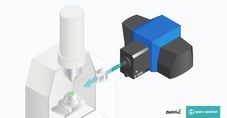-
Life Sciences
.png)
Our solutions
-
Materials Analysis
.png)
Our solutions
Techniques
Applications
- Why Delmic?
-
Insights
.png)
Insights
-
Company
.png)
Company
Materials Science
Advancing Nano-Optics Research With Delmic’s SPARC Spectral

We interviewed Prof. Nahid Talebi, who is on a mission to push the boundaries of nano-optics and to find new ways to understand quantum electrodynamics processes. Read here how Delmic’s SPARC Spectral CL detector has played a crucial role in her mission.
Background
Prof. Nahid Talebi
Prof. Nahid Talebi is a renowned scientist leading the Nanooptics group at Kiel University. Her group is dedicated to unraveling the intricacies of electron wavepackets, nanostructures, and light waves. They focus on mapping the dynamics of optical excitations at the nanoscale with sub-femtosecond time resolution. Their research delves into understanding the decoherence dynamics of single-photon emitters, integrated photonics systems, and polaritons' propagation dynamics.
Realizing Her Vision
Prof. Talebi faced specific challenges while realizing her vision for the research group. In order to map spectral interferometry using electron microscopes, she needed to modify the microscope to be able to install additional manipulators. She came up with the idea to use a cathodoluminescence detector inside a scanning electron microscope and to position an electron-driven photon source inside the chamber.
To achieve mutual spatial coherence, it was important to map the spatial profile of the radiation from the electron-driven photon source. Furthermore, it was crucial for the experimental geometry to have the CL mirror mounted below the sample instead of above.
A Flexible CL Detector
Seeking a versatile solution, Prof. Talebi approached Delmic. She ultimately chose Delmic’s SPARC Spectral CL detector due to its modularity and the company’s flexibility. Delmic's system not only enabled Prof. Talebi's team to characterize the spectral distribution of radiation but also to map its angular distribution, a crucial factor for obtaining the spatial radiation profile of the photon source.
“[I ultimately chose Delmic] because the Delmic system is modular: One can purchase and update the system incrementally.”
The modular design of the SPARC Spectral allowed for incremental updates as new advancements emerged. Moreover, it enabled the integration of new functionalities in the future, such as momentum-resolved spectroscopy. Additionally, to accommodate a novel type of CL interferometry, Delmic specifically designed the mounting of the mirror below the sample as a non-standard request.
Unique Experiments
The usage of Delmic's technology has had a profound impact on Prof. Talebi's research. In one of their initial experiments, the SPARC spectral, with its angle-resolved mapping and momentum-resolved spectroscopy capabilities, unveiled the potential of cathodoluminescence spectroscopy in mapping self-hybridized exciton-polaritons.
Additionally, the polarimetry setup enabled the team to discover a unique property of light in grating structures, effectively mimicking axion electrodynamics. These findings marked breakthroughs in understanding strong coupling effects, mutual coherence in cathodoluminescence radiation, and time-resolved spectroscopy with electron beams.
"I could rely very nicely on Delmic for support. The new developments were transferred and tested on our system, which allowed us access [..] in a very short period"
Delmic's team provided valuable consultations on new functionalities and promptly addressed their demands for additional information, fostering a friendly and efficient collaboration.
Future research
Since their breakthrough and publication, Prof. Talebi’s research has evolved, with plans to enhance their understanding of electron-light interactions within electron microscopes. They’re planning to implement more advanced experimental setups, aiming not only to map decoherence dynamics but also to explore nonlinear processes. While concrete experimental proofs-of-concept are yet to be revealed, the future looks promising for expanding the boundaries of quantum optics and electron microscopy - a thrilling and rapidly evolving field.
When asked for advice for researchers starting out in the field, Prof. Talebi emphasizes the importance of a multidisciplinary approach. Tackling concepts from multiple disciplines, such as optics and electron microscopy, is essential for comprehensive understanding. Furthermore, staying informed about advancements and recent developments is crucial, given the field's rapid and exciting progress.




